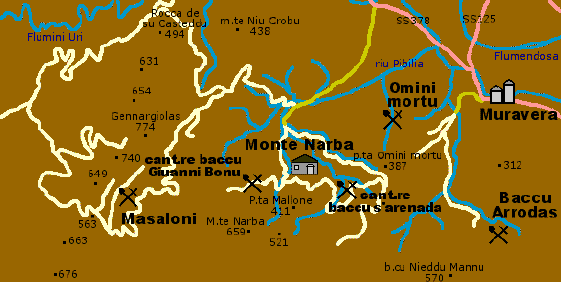 |
Sardinia's Mine |
|
Sardinia South East Mines |
|
The mines that are in the area of Narba Mountain exploit the silver vein of the Sarrabus in its eastern part . They are situated in the same geographical area (the mountains that are southeast of St. Vito and Muravera), and they exploited in different points the same vein of galene very rich in silver, finally they belonged to the same company (the Genoese Anonymous Society of the Mines of Lanusei).

From west east we have the following mines: Masaloni, Mountain Narba ( that includes the yards of Baccu Giovanni Bonu, Mountain Narba, baccu him Arenada), Dwarves Mortu, baccu Arrodas.
The best silver samples in Italy come from this area and in this section you can find some specimens of this that is the most important silver area in Italy.
The silver
mineralogical region of Sarrabus![]()
The region of the Sarrabus is set in the south eastern part of Sardinia. Its specificity from the mineralogical point of view is the presence both of native silver and of silver minerals. All the mines exploit a long band of about 35 kms of lenght (from Serpeddž mountain up to the inhabited areas of St. Vito and Muravera) and wide around 15, in direction Southwest - Northeast.

Starting from Southwest the mines of Tuviois they are met, Greenhouse him Ilixi, Nicola Secci, Tacconis, You Arcilloni (all along the course of the Rio Ollastu), Masaloni, Giovanni Bonu, Mountain Narba, Baccu Arrodas (in the slopes and throats of the mountains that crown the western part of the territories of St. Vito and Muravera).
The period of full activity of all these mines was from the last three decades of 1800 eight hundred to the first decades of 1900. Most of the mines and discoveries were made by the French engineer Leon Gouin, extremely active in searching, and constituting mining societies in the second half of 1800.
But the Sarrabus didn't mean only silver. Especially in period of italian autarchy, during the years '30 of the century just spent the region in the north of san Vito and Villaputzu was object of search and exploitation of small iron layers, whose economic relevance immediately drop after the reopening of the international markets, after the second world war.
From the fifties the increased interest of the industry toward the fluorine led to a serious search activity of this mineral with extraction in some mines. These anyway were closed following the discovery of the great fluorite ore of Silius, in the near Gerrei.